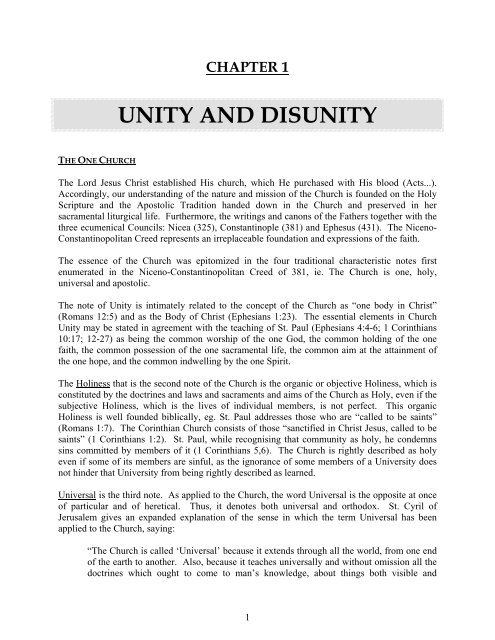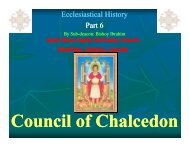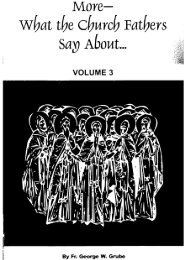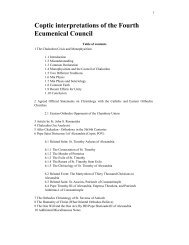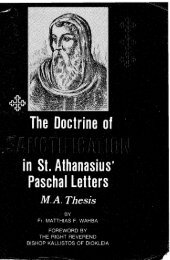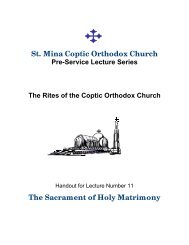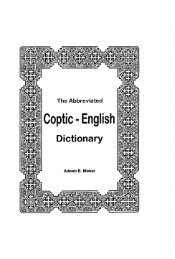Coptic Church & Ecumenical Movement - Saint Mina Coptic ...
Coptic Church & Ecumenical Movement - Saint Mina Coptic ...
Coptic Church & Ecumenical Movement - Saint Mina Coptic ...
Create successful ePaper yourself
Turn your PDF publications into a flip-book with our unique Google optimized e-Paper software.
THE ONE CHURCH<br />
CHAPTER 1<br />
UNITY AND DISUNITY<br />
The Lord Jesus Christ established His church, which He purchased with His blood (Acts...).<br />
Accordingly, our understanding of the nature and mission of the <strong>Church</strong> is founded on the Holy<br />
Scripture and the Apostolic Tradition handed down in the <strong>Church</strong> and preserved in her<br />
sacramental liturgical life. Furthermore, the writings and canons of the Fathers together with the<br />
three ecumenical Councils: Nicea (325), Constantinople (381) and Ephesus (431). The Niceno-<br />
Constantinopolitan Creed represents an irreplaceable foundation and expressions of the faith.<br />
The essence of the <strong>Church</strong> was epitomized in the four traditional characteristic notes first<br />
enumerated in the Niceno-Constantinopolitan Creed of 381, ie. The <strong>Church</strong> is one, holy,<br />
universal and apostolic.<br />
The note of Unity is intimately related to the concept of the <strong>Church</strong> as “one body in Christ”<br />
(Romans 12:5) and as the Body of Christ (Ephesians 1:23). The essential elements in <strong>Church</strong><br />
Unity may be stated in agreement with the teaching of St. Paul (Ephesians 4:4-6; 1 Corinthians<br />
10:17; 12-27) as being the common worship of the one God, the common holding of the one<br />
faith, the common possession of the one sacramental life, the common aim at the attainment of<br />
the one hope, and the common indwelling by the one Spirit.<br />
The Holiness that is the second note of the <strong>Church</strong> is the organic or objective Holiness, which is<br />
constituted by the doctrines and laws and sacraments and aims of the <strong>Church</strong> as Holy, even if the<br />
subjective Holiness, which is the lives of individual members, is not perfect. This organic<br />
Holiness is well founded biblically, eg. St. Paul addresses those who are “called to be saints”<br />
(Romans 1:7). The Corinthian <strong>Church</strong> consists of those “sanctified in Christ Jesus, called to be<br />
saints” (1 Corinthians 1:2). St. Paul, while recognising that community as holy, he condemns<br />
sins committed by members of it (1 Corinthians 5,6). The <strong>Church</strong> is rightly described as holy<br />
even if some of its members are sinful, as the ignorance of some members of a University does<br />
not hinder that University from being rightly described as learned.<br />
Universal is the third note. As applied to the <strong>Church</strong>, the word Universal is the opposite at once<br />
of particular and of heretical. Thus, it denotes both universal and orthodox. St. Cyril of<br />
Jerusalem gives an expanded explanation of the sense in which the term Universal has been<br />
applied to the <strong>Church</strong>, saying:<br />
“The <strong>Church</strong> is called ‘Universal’ because it extends through all the world, from one end<br />
of the earth to another. Also, because it teaches universally and without omission all the<br />
doctrines which ought to come to man’s knowledge, about things both visible and<br />
1


